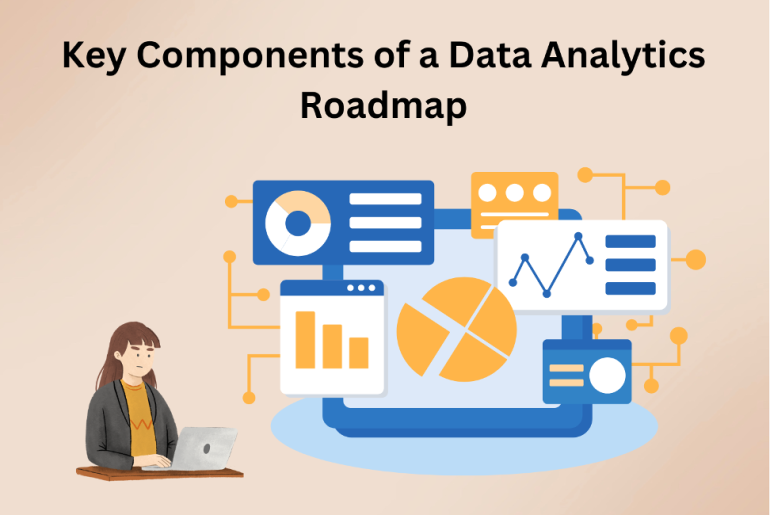Data analytics is becoming more critical for companies in the age of digital transformation to help them make better decisions and stay ahead of the competition. Becoming a data analyst typically begins with taking Data Analytics Courses. A Data Analytics Roadmap or other strategic plan is essential for maximising data analytics’ potential. This blog will discuss the elements that make up a successful Data Analytics Roadmap, which can help organisations and individuals strive for analytical excellence.
Table Of Contents
- What is a Data Analytics Roadmap?
- Elements of a Data Analytics Roadmap
- Conclusion
What is a Data Analytics Roadmap?
Data analytics roadmaps are strategic plans that outline the actions and checkpoints an organisation needs to reach its data-related objectives; they point in the right direction for data analytics to get valuable insights and make a difference. A well-organised plan is crucial for navigating data analytics, whether your goal is to improve business intelligence, streamline procedures, or obtain a competitive edge.
Elements of a Data Analytics Roadmap
Clear Business Objectives
Realising and fitting in with the company goals is the bedrock of any solid data analytics strategy. Data analysts can contribute more effectively to a company’s success when they have well-defined business goals to work towards. The roadmap must align with meaningful goals, like making customers happier, cutting expenses, or growing income.
Data Collection and Integration
Having access to high-quality data is crucial for analytics. Various data sources must be gathered and integrated according to the plans laid out in the roadmap. Part of this process is finding the right data sets, ensuring the data is good, and setting up practical ways to combine data. Before analysing and interpreting the data, this phase is necessary to set the stage.
Technology Stack and Infrastructure
Data analytics roadmaps must include the selection of appropriate technology stacks and infrastructure. Choosing the proper data storage, processing, and visualisation technologies is part of this. Regarding the technology of your analytics activities, cloud-based solutions, data warehouses, and analytics platforms are critical. The plan should detail how these parts will be tested and implemented.
Data Analysis and Modeling
Analysis and modelling of data constitute the backbone of every data analytics initiative. Choosing appropriate analytical methods, building models, and conducting exploratory data analysis are all part of this. Data analysts must be proficient in using methodologies, machine learning algorithms, and predictive modelling to derive valuable insights from data.
Visualisation and Reporting
The key to making well-informed decisions is effectively conveying insights. Data visualisation and reporting tools should be part of the roadmap so that dashboards and reports can be easily created and understood. Both the accessibility of data interpretation and the ability to communicate insights to varied stakeholders are improved by visualisation.
Data Security and Governance
Organisations must prioritise data security and governance procedures as they deal with larger and larger amounts of data. Data governance strategies must be part of the plan, including ownership definition, access control, and compliance requirements. This ensures that sensitive data remains intact and private throughout the analytics procedure.
Skill Development and Training
A data analytics plan can only be as good as the team behind it. Putting money into programmes that teach data analysts new skills is critical. The team will always be up to date on the latest tools and processes, which will help the organisation promote a culture of innovation and continuous progress.
Iterative Process and Continuous Improvement
Data analytics is an ongoing process that continuously improves upon itself. Feedback, changing company goals, and new technologies necessitate constant improvement, which the roadmap should reflect. The analytics projects are kept in sync with the organisation’s requirements through regular evaluations and tweaks.
Cross-Functional Collaboration
For data analytics programmes to be successful, cross-functional collaboration is essential. The roadmap’s goal should be to promote cross-functional collaboration by removing barriers between departments and encouraging a culture of open communication and sharing ideas. By working together, we can maximise the effect of data analytics on the lowest line.
Measuring Success and Key Performance Indicators (KPIs)
A data analytics roadmap must include key performance indicator (KPI) components. Your company’s goals should inform the development of key performance indicators (KPIs). Focus on these key performance indicators (KPIs) to see how well your analytics movements perform. With this data-driven strategy, the company can be sure it will reach its goals.
Conclusion
A carefully drawn roadmap in data analytics is the principle that leads businesses to valuable insights and long-term success. Each part is essential in making a data analytics journey a success, from setting clear business goals to building robust technological stacks and encouraging a culture of constant improvement. As more and more professionals take data analytics courses to improve their abilities, organisations can unlock data’s potential and experience transformational impact by implementing these essential components in a roadmap.

